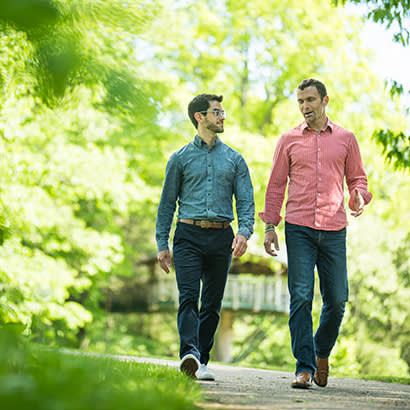
Twitter study shows the greener the urban green space, the more cheerful people become
Having one of those days — grumpy and blue? Head for the biggest, greenest park you can find and take a walk under some trees. Why?
A first-of-its-kind study by a team of scientists from the University of Vermont (UVM) shows that visitors to urban parks use happier words and express less negativity on Twitter than they did before their visit — and that their elevated mood lasts for up to four hours afterwards. The effect is so strong that the increase in happiness from a visit to an outpost of urban nature is equivalent to the mood spike on Christmas Day, by far the happiest day each year on Twitter.
With more people living in cities, and growing rates of mood disorders, this research may have powerful implications for public health and urban planning.
The new study, titled “Visitors to urban greenspace have higher sentiment and lower negativity on Twitter,” was published this summer in People and Nature, an open-access journal of the British Ecological Society.
Green Impact
For three months, the UVM team of scientists studied hundreds of tweets per day that people posted from 160 parks in San Francisco. “We found that, yes, across all the tweets, people are happier in parks,” says Aaron Schwartz, a UVM doctoral student who led the new research, “but the effect was stronger in large regional parks with extensive tree cover and vegetation.” Smaller neighborhood parks showed a smaller spike in positive mood and mostly paved civic plazas and squares showed the least mood elevation.
“In cities, big green spaces are very important for people’s sense of well-being,” says Schwartz. This means that efforts to protect and expand urban natural areas extend far beyond luxury and second-tier concerns. According to Taylor Ricketts, a co-author of the new study and director of the Gund Institute for Environment, “We’re seeing more and more evidence that it’s central to promoting mental health.”
In recent years, “a big focus in conservation has been on monetary benefits — like how many dollars of flood damage did we avoid by restoring a wetland?” Ricketts says. “But this study is part of a new wave of research that expands beyond monetary benefits to quantify the direct health benefits of nature. What’s even more innovative here is our focus on mental health benefits — which have been really underappreciated and understudied.”
Measuring Happiness
The hedonometer, an online instrument, has been gathering and analyzing billions of tweets for more than a decade. It was invented by a team of scientists at UVM and The MITRE Corporation, including Chris Danforth and Peter Dodds, professors at the Vermont Complex Systems Center and co-authors on the new study. The instrument uses a body of about 10,000 common words that have been scored by a large pool of volunteers for what the scientists call their “psychological valence,” a method for measuring each word’s emotional temperature.
The words the volunteers perceived as the happiest ranked near the top of a 1–9 scale; sad words near the bottom: “happy” ranked 8.30, “hahaha” 7.94 and “parks” 7.14. Truly neutral words, such as “and” and “the,” scored 5.22 and 4.98, respectively. At the bottom, “trapped” 3.08, “crash” 2.60 and “jail” 1.76. “Flowers” scored a pleasant 7.56. Using these scores, the team collects nearly 50 million tweets each day. “Then we, basically, toss the words into a huge bucket,” says Dodds, “and calculate the bucket’s average happiness score.”
Park Position
To devise the new study, the scientists gathered tweets from 4,688 users whose locations were geotagged with latitude and longitude in the city of San Francisco. “Then, working with the U.S. Forest Service, we developed some new techniques for mapping vegetation of urban areas — at a very detailed resolution, about a thousand times more detailed than existing methods,” says Jarlath O’Neil-Dunne, director of UVM’s Spatial Analysis Laboratory and a co-author of the new study. “That’s what really enabled us to get an accurate understanding of how the greenness and vegetation of these urban areas [relate] to people’s sentiment there.”
“This is the first study that uses Twitter to examine how user sentiment changes before, during and after visits to different types of parks,” says Schwartz, whose work is supported by the National Science Foundation. “The greener parks show a bigger boost.” Overall, the tweets posted from these urban San Francisco parks were happier by a dramatic 0.23 points on the hedonometer scale over the baseline.
The Cause of Affect
“While we don’t address causality in our study, we do find that negative language — like ‘not,’ ‘no,’ ‘don’t,’ ‘can’t’ — decreased in the period immediately after visits to urban parks,” says Danforth, “offering specific linguistic markers of the mood boost available outside.” Conversely, the study shows that the use of first-person pronouns — “I” and “me” — drops off dramatically in parks, perhaps indicating “a shift from individual to collective mental frame,” the scientists add.
For centuries, thinkers havewondered about the sources of happiness, and, for decades, psychologists have studied how to promote it, but this new study supports one fundamental insight: In nature, people tend to be happier. “That’s a finding that may help public health officials and governments make plans and investments,” says researcher Aaron Schwartz — and help you feel good about heading for the park.
Joshua Brown is a Science Writer whose work has appeared in the Boston Globe, U.S. News & World Report and Conservation. He writes and teaches environmental journalism at the University of Vermont.


